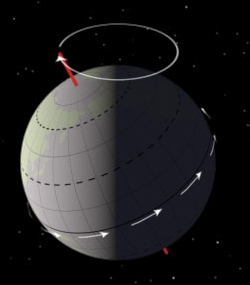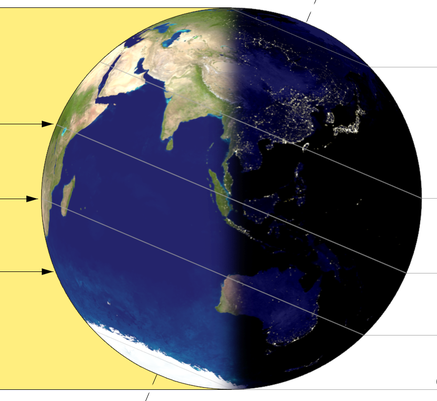The seasons are one way of dividing the year, based on the changing length of days and nights, weather changes, and the warming and cooling of the atmosphere.
In our region, these changes are described by four seasons: spring, summer, autumn, and winter.
The Earth has an imaginary line called the Earth's axis. The Earth rotates around this axis, which connects the North and South Poles. If the Earth's axis were vertical, day and night would each be 12 hours long. However, the Earth and its axis are tilted by 23.5 degrees, which means that the northern and southern hemispheres change their position relative to the Sun as the Earth orbits around it.
At different times of the year, sunlight hits different parts of the Earth at varying angles, causing places to be illuminated and heated differently. When the northern hemisphere is tilted toward the Sun, it receives more sunlight than the southern hemisphere. It is summer in the northern hemisphere and winter in the southern hemisphere. Six months later, the situation is reversed. Between these two extremes, spring and autumn occur.
Of course, the day is always 24 hours long, but the length of daylight depends on the season. In winter, the day is short and the night is longer, while in summer, the daylight hours are longer than the night.


Day and night are of equal length during the spring equinox (around March 21) and the autumn equinox (around September 23). At these times, both hemispheres are in the same position relative to the Sun, receiving an equal amount of sunlight, and the rays fall vertically on the equator.
The summer solstice occurs when the northern hemisphere experiences the longest day (around June 21). At this time, the northern hemisphere is tilted toward the Sun and receives more sunlight. The sun's rays fall vertically on the northern tropic.

The winter solstice occurs when the northern hemisphere experiences the shortest day (around December 21). At this time, the southern hemisphere is tilted toward the Sun, so the northern hemisphere receives fewer sunlight rays. The sun's rays fall vertically on the Tropic of Capricorn (the southern tropic).

You can find many interesting animations online about Earth's orbit around the Sun and the changing of the seasons. One of them (in English) is also HERE.

